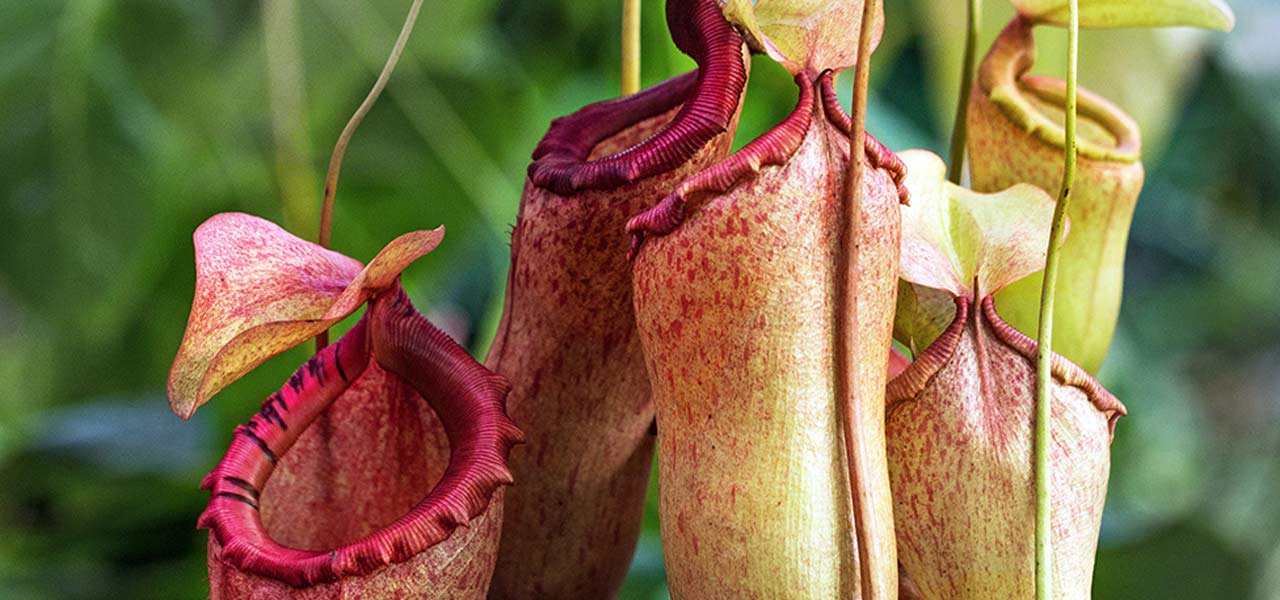Your Cart is Empty
spend R1000. 2kg or less. free shipping.
Menu

spend R1000. 2kg or less. free shipping.
bonsai
gardening
Orchids

Nepenthes Essentials
3 min read
About
Nepenthes, commonly known as Tropical Pitcher Plants, are the largest of any carnivorous plant varieties. Native to Southeast Asia, their modified carnivorous leaves form pitfall traps with digestive fluid-filled bottoms, allowing them to climb and capture prey.

Habitat
Over 300 species, with small growing ranges, often limited to specific islands or highlands, span Nepenthes. Their habitat ranges from cool mountain highlands to warm sea level rainforests, with most diversity in the Malay Archipelago. Generally, they divide into "Highland" and "Lowland" species, differentiated by elevation: Highland, >3300ft (1000m), and Lowland, below. Carnivorous Plant growers with cooler winters may favor Highland varieties, while those in warmer climates might prefer Lowland.
These plants usually thrive in sunny, exposed spaces, creeping up shrubbery and trees or in grassy plains. Soil is usually acidic and poor in nutrients, being composed of sand, volcanic material and peat.(Check out our acidic media including Kanuma, Lava and Akadama)

The pitcher
Their traps are great at luring, catching and digesting insects. They catch more than any other carnivorous plant, including stink bugs, yellow jackets and wasps. Pitcher Plants, Sarracenia, look and work similarly, but traps form on mid-vein tendrils. In the wild, pitchers hold 20-30% digestive fluids, secreted by the plant and diluted by rain.

How to care for Nepenthes
Sunlight
Nepenthes prefer bright light without much direct sunlight -- usually up to 50%. For optimal growth, dappled shade or plant lights with a broad spectrum are recommended, but should be kept at a distance to prevent overheating. Poorly developed plants and discoloration can be indications of light that is too weak. Sunburn may appear as red or dead zones on the apex of the plant, facing the sun or light source.

Water
Nepenthes require a consistently moist substrate, and should be intermittently inundated to reduce the concentration of any salts that may have accumulated. Water from rain, distilled or purified sources should be employed, but tap water may be acceptable in areas of low salinity and chloride.
Humidity
Nepenthes typically require a fairly humid atmosphere to produce the highest number of pitchers but survive in lower humidity levels. Greenhouses, terrariums, and makeshift tents with clear plastic bags are some ways in which to achieve these higher humidity environments for the plants but this is often not necessary and the average house has sufficient humidity.
Temperature
Most varieties thrive in temperatures ranging from 12-35 deg C, with the Highland species flourishing when nights are cooler (near 12-16 deg C) and days are milder (21 - 30 deg C). Lowland types, meanwhile, can tolerate higher temperatures and are usually easier to cultivate.
Planting Mixes
A successful planting medium may include long fiber sphagnum moss, peat moss, pumice, perlite, lava stone, akadama and kanuma. Mixes featuring combinations of these components are recommended.
Containers
It is vital that the environment be well-ventilated and the container sufficiently drained. Avoid clay pots as salts tend to accumulate in them. A replanting should be considered when the media degrades, the plant shows signs of excessively dryness, or a more substantial pot size is need. One of the best ways to grow and show off a Nepenthes is a plastic hanging basket. When growing on a surface a plastic container considerably taller than it is wide is best.
Feeding
If you are growing the plant where it cannot catch insects for long periods, you can add an occasional small insect such as a fly, a cockroach or a few very small insects to mature pitchers. This is not normally needed. You can also mix a dilute solution of Seagro or Seabrix and inject this into the pitchers with a syringe. Margaret Roberts Supercharger liquid fertilizer has also shown to produce good plant growth when used as a foliar feed.

Propagation
Nepenthes are typically propagated from cuttings, and seed, but it can take a while to get a good size plant, even years. Tissue culture is another common propagation technique, especially of interesting clones. Nepenthes should be repotted with fresh soil mixevery few years.
Leave a comment
Comments will be approved before showing up.
Recent Articles
- Enthusiasts Top Wiring Tips July 17, 2023
- Top fertilizing tips March 28, 2023
- Top watering tips February 13, 2023
- Creating Japanese Maple forests October 24, 2022
- How to dig bonsai material August 15, 2022
- How I style bonsai and you can too April 30, 2022
- Swamp Cypress Bonsai Styling July 03, 2021
- How to hide large scars quickly June 14, 2021
- 14 Tips for Field Growing Bonsai May 31, 2021
- Aquaria: An Introduction January 06, 2021

FREE SAMPLE GIVEAWAY!
We are giving away samples of our new product, SuperBoost fertilizer pellets.
A unique organic blend of Blood meal, Bone meal, Canola meal, Fish meal, Fish hydrolysate. Macro, micro and trace minerals. Plant natural stimulating hormones, enzymes and amino acids.




